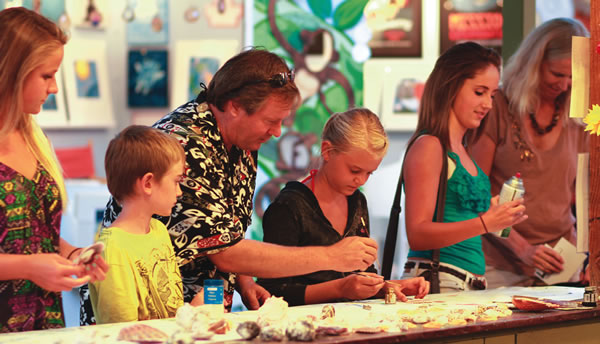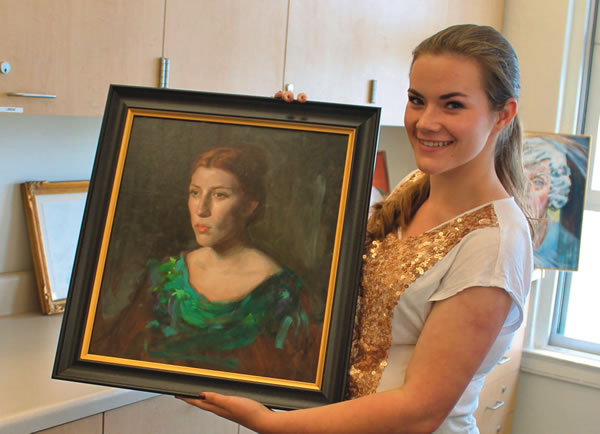Laguna summer festivals inspire art appreciation and assist young people in achieving their artistic dreams.
By Vicki Hogue-Davies
 Five-year-old Julie Setterholm watched wide-eyed as Sawdust Art Festival exhibitor Dion Wright welded and assembled a dinosaur sculpture. Seeing Dion and the other artists working made her realize that people created with their own hands and not everything came from a store. During the following summers at Sawdust, she learned to make art herself, soaking up all that the exhibitors taught her.
Five-year-old Julie Setterholm watched wide-eyed as Sawdust Art Festival exhibitor Dion Wright welded and assembled a dinosaur sculpture. Seeing Dion and the other artists working made her realize that people created with their own hands and not everything came from a store. During the following summers at Sawdust, she learned to make art herself, soaking up all that the exhibitors taught her.
“They didn’t have [Children’s Art] Spot yet,” she says of when she was a child. “They mostly had artists … in their booths. I would bounce around and hang out near people who did stuff I liked.”
In addition to Dion, those people included an artist that Julie remembers named Tara, but liked to be called “Flying Horse,” who let Julie “look over her shoulder,” guiding her in the art of making silver and copper jewelry. Julie’s own grandmother, Mary Alice Hamilton, taught her about copper enameling. She soldered with Earl Reed. Artist Marcus Miller taught her to weld with the torch when Julie was 19. Julie appreciates what they taught her and that they gave her the chance to try on their equipment.
“Being around the artists at Sawdust I realized I could do that too,” she says. “Once that entered my head, life became a different story and I’m really grateful for that.”
Artistic Possibilities
Julie is now a Sawdust exhibitor herself, inspiring future generations of artists. She has shown her copper sculpture and jewelry there for 11 years.
“It was the individual artists teaching me from their booths who influenced me,” Julie says. “I try to do the same thing from my booth. The awe I see in kids’ eyes when they realize they could do that too—it is just magical.” This year for the first time, she will teach a two-day class in enameling.
At Sawdust, workshops and demonstrations spark creativity and allow kids and teens to learn from professional, practicing artists. At the popular Children’s Art Spot, kids ages 4 to 8 learn about painting and apply their knowledge using non-toxic paints.
“The kids do different paintings depending on the artist who is teaching,” says Jane Hilary, art activities manager for Sawdust. She adds that the age range isn’t strict. “If a mom wants to bring kids who are older or younger, we accommodate them.”
At Studio One, visitors ages 7 and up learn painting, collage-making, printmaking and other arts and crafts. The Ceramic Center provides one-on-one instruction for all ages at the potter’s wheel. “As long as a child can sit up by themselves, they can get their hands on the clay,” Jane says. “They will have somebody working with them to help.”
Sawdust classes and workshops are often planned around different themes, such as Surf Day or ’60s Day. “For example, for the ’60s, we might do a ‘Yellow Submarine’ project … or highlight artists like Andy Warhol who were famous during the period,” Jane says. Workshop and demonstration schedules are posted at the festival’s main entrance and announced publicly throughout the day.
“Art in the schools is virtually nonexistent for most kids, so they absolutely lap it up,” Jane adds. “We emphasize the educational aspects of the pieces and do things they wouldn’t do in school; we really want to educate.”
Young Exhibitors
Across the street from Sawdust at Festival of Arts, the Junior Art Exhibit showcases art pieces created by more than 300 Orange County kids, from kindergarteners to high school seniors. Competition to get into the exhibit, held since 1947, is tough. Last year, more than 6,000 art pieces were submitted by teachers from schools throughout the county.
“I still remember how proud I felt when I saw my painting in the exhibit [in 1967],” says watercolor artist Molly Hutchings, a festival exhibitor for 20 years. Molly now serves as a Junior Art Exhibit juror. “I had not known that my painting (an abstract watercolor landscape) was being submitted by my art teacher, so it was a big surprise to find out that it had been accepted into the exhibit. My self-confidence was boosted.” Molly, who attended San Clemente High School, went on to major in art at Sonoma State University.
“Acceptance at a tender age can have a positive influence on a child, so I love being part of that,” Molly says. “But I also have empathy for those whose work is not accepted. All the jurors give due respect to the art created by the young people. Sometimes it seems they do some of the best work in the whole show.”
Also at FOA are Youth Arts Education Classes, which teach young people ages 7 to 12 about mixed media, jewelry-making and more. The classes are held Monday through Friday July 2 to Aug. 30, and reservations are required.
The Art Business
Each year, the nonprofit Art-A-Fair Foundation awards scholarships to two Orange County high school students. The scholarships allow awardees to exhibit in a shared booth at the summer Art-A-Fair Festival and be mentored by experienced exhibitors. The foundation looks for juniors or seniors planning to major or minor in art, according to Ron McWhorter, foundation president.
“We pay for their booth, framing, art cards and other supplies,” he says. “We teach them how to sell and market. We teach them about price points and basically all the business parts of the art world.”
The students help set up their booth, attend the show on opening night and attend the festival for a predetermined number of hours on the weekends. They keep all the money they earn from their sales to continue their pursuit of the arts.
“It is one of the best experiences I have had in terms of exhibiting art,” says 18-year-old Callie Fink, a 2012 scholarship recipient. “I loved being able to interact with professional artists who are a lot older and more experienced than me. I would never have expected to stand at the same level as all of these great artists and show with them.”
Callie graduated from Santa Ana’s Foothill High School and is now attending Coastline Community College. She plans on moving to Orange Coast College in the fall where she will major in art and illustration. The money she earned from the scholarship is helping pay for college and art supplies, which she notes are very expensive.
The Art-A-Fair Foundation also provides art supplies to Orange County classrooms hit hard by budget cuts and to programs for kids who are underprivileged or victims of domestic abuse. Additionally, it sponsors the Art Masters program in Tustin, which brings visual arts education to underserved elementary schools in the city, and other local arts programs.
Granting Education
“LOCA [Laguna Outreach for Community Arts] is our biggest receiver of grants,” says Scott Moore, president of the FOA Foundation. “We give them an average of $25,000 a year to help fund their particular programs.” LOCA programs include art workshops in Laguna schools and at the Boys & Girls Club of Laguna Beach.
Other foundation grant beneficiaries are the My Hero Project, which allows kids to talk about the heroes in their lives through art, and the Laguna College of Art & Design (LCAD). “We give [LCAD] $10,000 each year and request that they give that money to a Laguna Beach arts student attending the college to help with tuition,” Scott says.
“I feel fortunate to know the grant program works,” he adds. Scott has been an exhibitor for 35 years at FOA. “[Those kids] will be taking my place eventually. You know your money went to the right place when you see these young people standing next to you at the festival.”
Passing the Torch
Each year, FOA awards college scholarships to residents for music, art, dance, film, writing, drama and both vocal and instrumental music education. “They do not even have to major in art,” says Pat Kollenda, FOA board member and scholarship committee chair. “They could major in engineering, for example, as long as they take one accredited class in the art they were awarded in. It is all about the nurturing of art in all its wonderful forms.”
More than $3 million in college scholarships have been awarded. Potential awardees audition and interview with the scholarship committee.
“The interview process is unusual for a scholarship application because you meet face-to-face with board members on the committee,” says Diane Challis Davy, Pageant of the Masters director. Diane received a festival scholarship after graduating from LBHS in 1975. “They take a special interest in your work and are really encouraging and helpful. As a senior it was nice to have that attention from [festival] mentors. … I had no idea at the time that I would end up spending most of my life working for the festival.”
Artist Robin Wethe Altman of Laguna’s Watercolor Gallery attended Principia College in Illinois, and received a bachelor’s degree in fine arts in 1976 with the help of a festival scholarship.
“The college had a wonderful art department,” she says. “My professor, James Green, was part of the California regionalist movement. He was extremely dedicated to students and a real mentor. We went to Switzerland, France, Italy and England on an art tour. The school had connections with major museums and we were able to go behind the scenes and see Rembrandts and Picassos. … It would have been really tough to go to that kind of school without the scholarship.”
When the first artists came to Laguna and began painting, they did it for the love of art. Today’s youth are finding their own inspiration here, and assisted by the educational and financial support of the art festivals, they will carry the creative torch of the early artists far into the future. LBM








